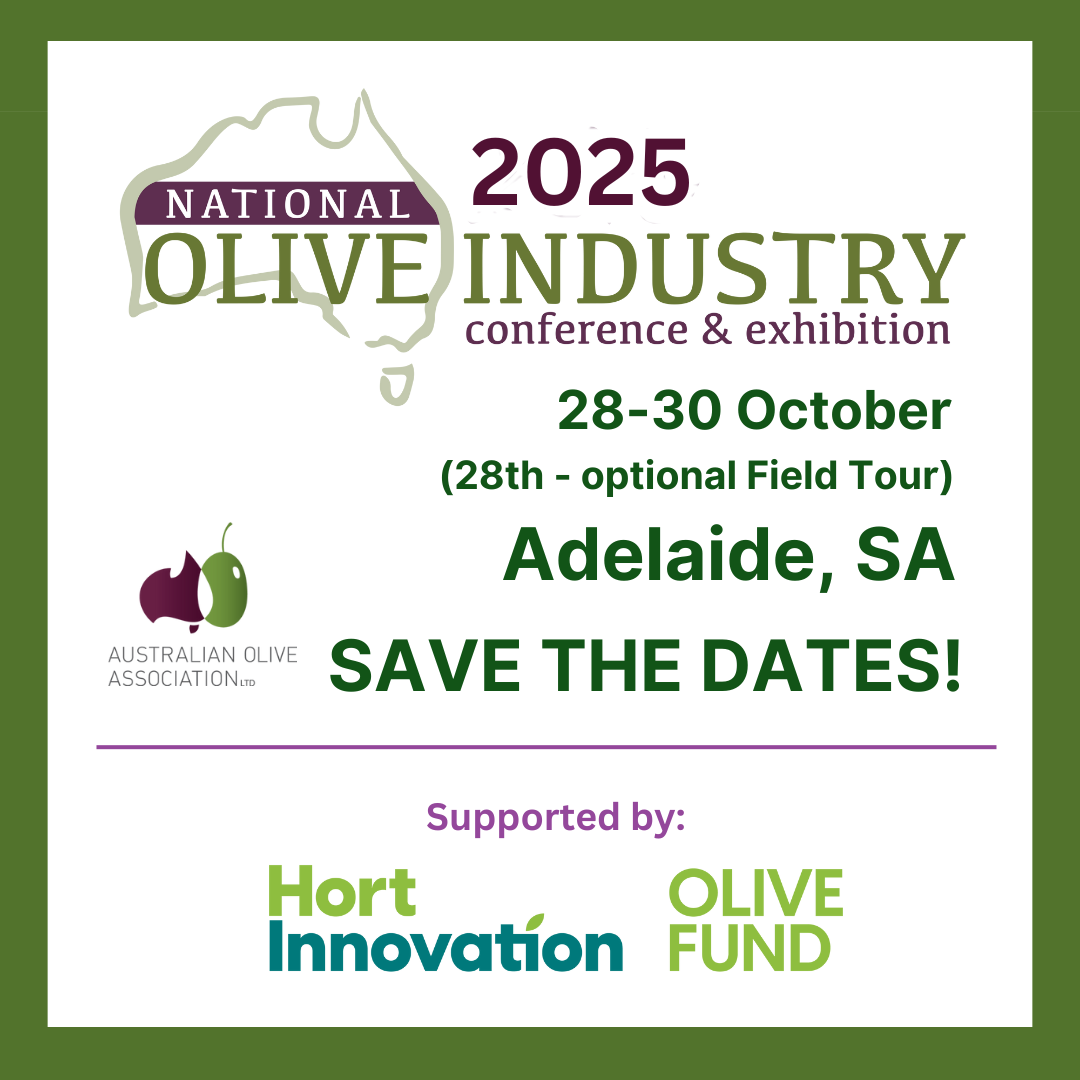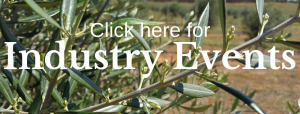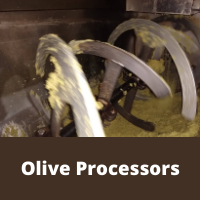The following is a status report on the 32 RIRDC publications that are available on the Agrifutures website (links available below).
AOA has identified:
• 16 R&D reports for review and update with the reviewer identified as listed below:
• 7 R&D reports as current and relevant as published.
• 9 R&D reports as obsolete or superseded
The review comprises the following steps:
• Preparing a one page Review / Gap Analysis identifying those sections of the nominated publication(s) requiring revision / updating.
• Preparing an “Addendum” to update the nominated publication(s).
Table Olives
|
|

Download report: Table Olive Production Manual | AgriFutures Australia Table Olive Production Manual RIRDC Publication 12-100, October 2012 Author: J D Smyth This publication is a practical guide for all table olive producers. It includes an overview of Hazard Analysis Critical Control Point (HACCP) principles for table olives within the framework provided by the Food Standards Australia New Zealand (FSANZ) Food Standards Code. It provides an overview of table olive processing equipment and materials, as used in both small-scale and large-scale production. In addition, it provides detailed descriptions of methods involved in the processing and packaging of both small and large batches of green and black olives, with references to the new Voluntary Industry Standard for Table Olives in Australia. Comments: Essential reading for table olive producers. Reviewer – Professor Stan Kailis PhD BSc(Hons) Dip Pharm Teacher Certificate (Tech). Olive and Oil Specialist, Director – Australian Mediterranean Olive Research Institute Review completed – to be published in Olivegrower and processor December 2020 Download review HERE |
|
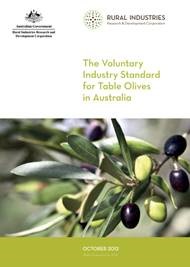
Download report: The Voluntary Industry Standard for Table Olives in Australia | AgriFutures Australia The Voluntary Industry Standard for Table Olives in Australia RIRDC Publication 12-111, October 2012 Author(s): National Table Olive Committee The Voluntary Industry Standard for Table Olives in Australia (the Industry Standard) has been prepared by the National Table Olive Committee (NTOC) of the Australian Olive Association Ltd (AOA). It is a voluntary industry standard that establishes an objective basis for the wholesale and retail trade of table olive products in Australia. The Industry Standard will ‘lift the bar’ for Australian table olive producers, in terms of improved product quality, food safety and productivity. The benefits to producers, wholesalers and retailers in having a clear objective industry standard will also deliver associated benefits to all consumers of Australian table olives. Comments: Essential reading for all table olive producers. Underpins OliveCare® table olive production best practice and certification. Profiled in OliveCare® NEWS, March 2019. Reviewer – Professor Stan Kailis Review completed – download here |
|
|
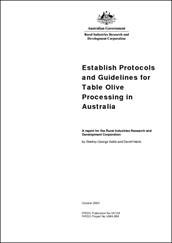
Download report: Establish Protocols and Guidelines for Table Olive Processing in Australia | AgriFutures Australia Establish Protocols and Guidelines for Table Olive Processing in Australia RIRDC Publication 04-136, October 2004 Author(s): Stanley G. Kailis The Australian table olive industry/trade currently has no nationally accepted guidelines for ensuring the quality and safety of processed table olives. The aim of the project was to scope the Australian table olive industry, compile quality and safety data by laboratory investigation and from the literature, and prepare a manual for olive growers and processors. This report covers these objectives from both national and international viewpoints and the manual is presented as a second publication from this project. RIRDC report ‘Establish Protocols and Guidelines for Table Olives Processing in Australia’, and a companion manual – ‘Producing Table Olives 2007’, by Professor Stan Kailis and David Harris provides Australian olive growers and processors with internationally based guidelines for ensuring the quality and safety of processed table olives. Comments: This publication is superseded by: The Voluntary Industry Standard for Table Olives in Australia RIRDC Publication 12-111, October 2012, Author(s): National Table Olive Committee |
EVOO Chemistry and Quality
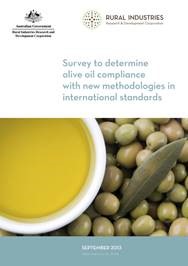
Download report: Survey to determine olive oil compliance with new methodologies in international standards RIRDC Publication 13-094, September 2013 Author(s): Claudia Guillaume, Leandro Ravetti, Natalia Ruiz, Daniella Zaparenkov This report describes quality characteristics of Australian olive oil and compares the findings to recent changes and proposals to standards used in international trade. The report shows the effects of olive cultivars, the influence of harvest timing and the changes to quality as a result of site and seasonal growing conditions. Currently genuine olive oil can be rejected as adulterated when it is outside existing regulations. Results in this report clearly describe quality characteristics of premium quality, extra virgin olive oil grown under Australian conditions. Comments: This publication is current and relevant. Profiled in OliveCare® NEWS, September 2019. |
||
|
Evaluation of New Analytical Methods to Detect Lower Quality Olive Oils | AgriFutures Australia Evaluation of New Analytical Methods to Detect Lower Quality Olive Oils RIRDC Publication 12-007, June 2012 Author(s): Claudia Guillaume, Leandro Ravetti This RIRDC report provides information about the effect of exposure to oxygen, light and storage temperature on the quality of olive oil. Olive oil has been shown to quickly deteriorate when stored under less than ideal conditions. Sometimes growers produce oil with very high quality initially, which quickly deteriorates due to the conditions under which it is stored. The report is targeted at olive oil producers, transporters, warehouse operators, importers and exporters, retailers and consumers. It is important to be aware of the risks of improper storage on olive oil quality whether buying, selling, transporting or storing the product. Comments: This publication is current and relevant. Profiled in OliveCare® NEWS, September 2019. |
||
|
Sterols in Australian Olive Oils: The effects of technological and biological factors RIRDC Publication 10-173, October 2010 Author(s): Leandro Ravetti, Joshua Johnson, Claudia Guillaume Plant sterols have been found to be effective in lowering elevated cholesterol and are now being added to a wide range of foods. Ironically, international standards for olive oil set a low limit for phytosterols. Due to natural variations in oils from new growing areas such as Australia, some Australian oils have higher levels of phytosterols. The total content of sterols and their composition in olive oil seem to be influenced not only by genetic factors but also by management and processing techniques. The aim of the report was to improve processing and product quality while meeting national and international standards through supporting consistent production of high quality, healthy and safe olive oil that meets consumer expectations and in which they have confidence. Comments: This publication is current and relevant. Profiled in OliveCare® NEWS, July 2019. |
||
|
Harvest-timing, Sensory Analysis and Shelf Life for Optimal Olive Oil Quality RIRDC Publication 10-177, October 2010 Author(s): Rodney J. Mailer, Jamie Ayton Oil quantity and quality rely heavily on crop management, harvest timing, processing methodology and storage. In the initial stages of the development of this industry, there was little understanding of the intricacies of these crop management practices and the resultant crop yield, chemical quality and sensory attributes such as taste, colour and odour. For these reasons, this RIRDC study has been undertaken to look at the significance of irrigation treatments and harvest timing on oil quality, yield and sensory characteristics. Comments: Essential reading for EVOO producers and competition judges. Profiled in OliveCare® NEWS, July 2019. Relevant but needs updating Reviewers: Dr Rod Mailer / Jamie Ayton Review completed – published in OliveCare® NEWS December 2019 Download here |
||
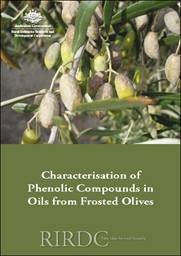
Download report: Characterisation of Phenolic Compounds in Oils Produced from Frosted Olives | AgriFutures Australia Characterisation of Phenolic Compounds in Oils Produced from Frosted Olives RIRDC Publication 09-058, May 2009 Author(s): Leandro Ravetti, Sonja Gwyn, Claudia Guillaume This RIRDC report summarises findings and statistical analysis of data generated when researching the characterisation of phenolic compounds in oils produced from frosted olives. It is research that will be of interest to current industry participants, the olive research community and analytical laboratories. Frost is one of the most important weather related hazards for the Australian olive industry and has caused significant economic losses during the past decade. Its impact on oil quality has been significant in 2006 with more than 20 per cent of Australian oil of that year being affected to some degree. Early frosts will normally affect the fruit leading to significant changes in the chemical and organoleptic characteristics of the oils. Comments: Essential reading for EVOO producers and competition judges. Profiled in OliveCare® NEWS, February 2019. This publication is current and relevant. |
||
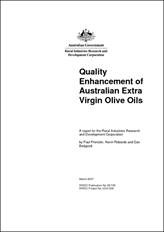
Download report: Quality Enhancement of Australian Extra Virgin Olive Oil | AgriFutures Australia Quality Enhancement of Australian Extra Virgin Olive Oil RIRDC Publication 06-135, March 2007 Author(s): Paul Prenzler, Kevin Robards, Dan Bedgood The quality of olive oil is largely determined by the minor components, especially volatile (aroma, flavour) and phenolic (flavour, antioxidant) compounds. We have devoted a large part of this study in identifying and monitoring these compounds (among others) in fruit, and during processing and oil storage, while exploring how these stages may affect levels of these compounds and hence consumer satisfaction and acceptance. We show in this study that it is possible to have objective, reproducible, reliable measures of many of the compounds that affect the sensory properties of olive oil, and hence consumer satisfaction and acceptance. Comments: Essential reading for EVOO producers and competition judges. This publication is relevant but needs an update. Reviewer: Dr Paul Prenzler (CSU) Review completed – published in OliveCare® NEWS November 2019 Download here |
||
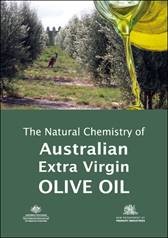
Download report (English): The Natural Chemistry of Australian Extra Virgin Olive Oil (English Version) | AgriFutures Australia Download report (Mandarin): The Natural Chemistry of Australian Extra Virgin Olive Oil – Traditional Chinese Translation | AgriFutures Australia The Natural Chemistry of Australian Extra Virgin Olive Oil (English Version) RIRDC Publication 06-132, January 2007 Author(s): Rod Mailer Australian Olive Oil is extracted by mechanical means. The oil is not blended unless stated on the label. The natural and diverse range of environments and growing conditions account for the significant variation in its inherent chemical composition and sensory properties. This report is a result of collaboration between RIRDC and the NSW DPI Wagga Wagga Research Institute and is strongly supported by the Australian olive industry. It reflects the desire of Australian olive growers to produce a unique range of authentic and fresh olive oils that are well defined for consumers. Comments: Essential reading for EVOO producers and competition judges. Profiled in OliveCare® NEWS, August 2019. Relevant but needs an update. Reviewers: Dr Rod Mailer / Jamie Ayton Review completed Download here |
Pests & Diseases
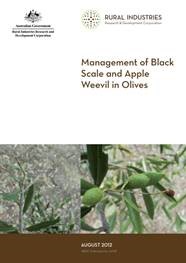
Download report: Management of Black Scale and Apple Weevil in Olives | AgriFutures Australia Management of Black Scale and Apple Weevil in Olives RIRDC Publication 12-019, August 2012 Author(s): Sonya Broughton, Stewart Learmonth This Rural Industries R&D Corporation report provides olive growers with monitoring, and organic and conventional control methods for black scale and apple weevil. The information generated by this project also provides new methods to improve control of apple weevil. Comments: Essential reading for all olive producers. Profiled in OliveCare® NEWS, May 2019. Whilst published with a focus on WA groves but now increasingly relevant in other states. Stewart Learmonth, one of the authors, has presented the results of this work at the WA IPDM field days in 2019, and is providing input into the extension material (including the updated field guide) to be produced as part of OL17001. This publication is relevant but needs a minor update Reviewer: Stewart Learmonth / Alison Mathews Review completed – download here |
||
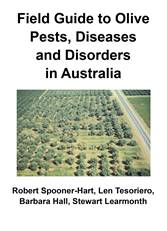 Download revised publication: Field Guide to Olive Pests, Diseases and Disorders in Australia | AgriFutures Australia Download revised publication: Field Guide to Olive Pests, Diseases and Disorders in Australia | AgriFutures Australia
Field Guide to Olive Pests, Diseases and Disorders in Australia RIRDC Publication 07-153, October 2007 (Updated September 2020) Authors: Robert Spooner-Hart, Len Tesoriero, Barbara Hall, Stuart Learmonth The revised Field Guide to Olive Pests, Diseases and Disorders provides updated Australian information as well as inclusion of new exotic pests and diseases (such as Xylella and Verticillium wilt (Defoliating strain)). It is primarily to assist in identification of possible pests, diseases and disorders, as well as important beneficial natural enemies. Comments: Essential reading for all olive producers and pest scouts. Outputs from OL17001 include on-line tutorials, flyers, revised field guide and best practice IPDM manual: https://olivebiz.com.au/ipdm-project-outputs/ |
|
|
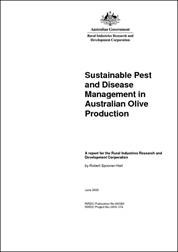
Download report: Sustainable Pest & Disease Management in Australia Olive Production | AgriFutures Australia Sustainable Pest & Disease Management in Australia Olive Production RIRDC Publication 05-080, July 2005 Author(s): Robert Spooner-Hart Although Australia appears to be free of many cosmopolitan olive pests, the rapid expansion of the olive industry in all mainland states has led to increased problems with pests and diseases not previously encountered. This publication reports on numerous workshops on pest and disease recognition and their sustainable management, monitored pest and beneficial species in groves and identified a number of previously unreported pests and diseases. Comments: Useful background reading for all olive producers and pest scouts. This was the final report of a project conducted in the early 2000s. As such it is a historical record of an industry survey and IPDM field days. It was very similar to the current project OL17001; thus, the latter project supersedes it. |
Olive Production & Grove Management
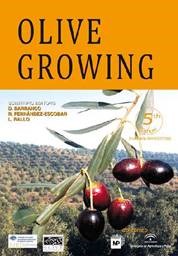
Download chapter 1: Olive-Growing-Manual-Chapter-1.pdf (australianolives.com.au) Olive Growing (El Cultivo Del Olivo) RIRDC Publication 09-067, October 2010 Author(s): D. Barranco, R. Fernandez-Escobar, L. Rallo This new English edition of Olive Growing (El Cultivo Del Olivo) was developed by RIRDC and the AOA as a translation and update of the 5th edition of the Spanish manual (2004). It is intended as a definitive reference source for the Australian olive industry and will also be an asset for olive producers and processors in other English speaking countries. Comments: Essential reference for all olive producers / processors. Profiled in OliveCare® NEWS, April 2019. Current and relevant but needs statistics update and adding the content of new version of the Spanish edition. Reviewer: Paul Miller |
||
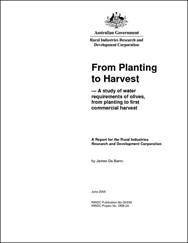
Download report: From Planting to Harvest – A Study of Water Requirements of Olives, from planting to first commercial harvest RIRDC Publication 05-039, June 2005 Author(s): James De Barro This cost-effective research aimed to increase the understanding of young olive water use and water requirements in the period from planting to early fruit bearing. Quantification of the volumetric water requirements of olives from planting to early fruit bearing would permit optimising tree development and provide a reference point for developing specific irrigation strategies. Comments: Useful background reading for all olive producers. Reviewer: Dr. Ketema Tilahun Zeleke Senior Lecturer – Agricultural Water Management School of Agricultural and Wine Sciences Charles Sturt University, Wagga Wagga, Australia Review completed – published in Olivegrower and processor December 2020 Download review here |
|
|
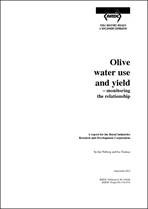
Download report: Olive water use and yield – monitoring the relationship | AgriFutures Australia Olive water use and yield – monitoring the relationship RIRDC Publication 03-048, September 2003 Author(s): Ian Nuberg, Isa Yunusa This publication presents a project that monitored the water use of trees across four mature groves in South Australia for two growing seasons. The aim of the project was to provide estimates of evapotranspiration during the growing season, characterise the relationship between water use and olive yield, and provide guidelines for efficient management of irrigation water for optimum yields. The report shows how grove management affects water use and that the irrigation regimes of the monitored groves were not optimal for olive yield. It shows the necessity of developing irrigation practices that prevent shortage of water during the middle of growing season in mid-summer, and which partition more of the evapotranspiration through the transpiration pathway to ensure high olive yield and water-use efficiency. Comments: Useful background reading for all olive producers. Reviewer: Dr. Ketema Tilahun Zeleke Senior Lecturer – Agricultural Water Management School of Agricultural and Wine Sciences Charles Sturt University, Wagga Wagga, Australia Review completed – published in Olivegrower and processor December 2020 Download review here |
Olive Harvesting
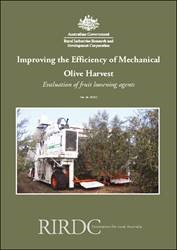
Download report: Improving the Efficiency of Mechanical Olive Harvest: Evaluation of fruit loosening agents | AgriFutures Australia Improving the Efficiency of Mechanical Olive Harvest: Evaluation of fruit loosening agents RIRDC Publication 08-052, September 2008 Author(s): Leandro Ravetti and Brigid McClelland This RIRDC publication outlines the findings of a two-year trial evaluating the currently available fruit loosening agents employed under Australian conditions in order to determine their cost effectiveness and conditions for their commercial use. The forces that lead to mechanisation in agriculture are clear – high cost and availability of manual labour. For some crops, these economic forces have led to rapid adoption of mechanisation, for others, like olives in the Mediterranean basin the pressure for mechanisation has been growing at a much slower pace. This report will be useful for Australian olive growers and will provide supporting information to support registration with the APVMA to enable legitimate use of this chemical in Australian conditions. Comments: Useful reading for all olive producers and harvesters, to be read in conjunction with product labels. This publication current and relevant. Profiled in OliveCare® NEWS. To Be Advised |
||
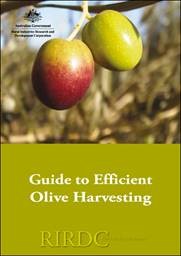
Download report: Guide to Efficient Olive Harvesting | AgriFutures Australia Guide to Efficient Olive Harvesting RIRDC Publication 08-157, October 2008 Author(s): Leandro Ravetti Provides olive growers with information to assist them to achieve improved harvest efficiency. The manual presents optimal harvest efficiency options for the full range of mechanisation and scales of operation experienced by growers in the Australian environment – from hand harvesting to large scale operations. It also provides information on the theory and practice of harvest efficiency, including the physiology of the olive tree, grove design and management and the range of options of mechanisation. Comments: Useful reading for all olive producers and harvesters. This publication is current and relevant. Profiled in OliveCare® NEWS, May 2019. |
|
|
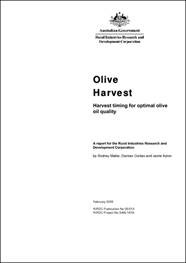
Download report: Olive Harvest | AgriFutures Australia Olive Harvest RIRDC Publication 05-013, February 2005 Author(s): Rodney Mailer Damian Conlan, Jamie Ayton This report details findings through the stages of fruit maturity from soft stone to black olives. It describes the range of factors individually, as well as the relationship with other parameters, which are important for the product to be considered high quality oil. Indicators are provided to identify the time to harvest fruit to optimise particular traits such as oil yield, oil quality, sensory characteristics and good shelf life stability. Comments: Essential reading for EVOO producers and competition judges. Needs to be read in conjunction with a later report: Harvest-timing, Sensory Analysis and Shelf Life for Optimal Olive Oil Quality, RIRDC Publication 10-177, October 2010, Author(s): Rodney J. Mailer, Jamie Ayton. Reviewers: Dr Rod Mailer / Jamie Ayton Review completed – published in OliveCare® NEWS December 2019 Download here |
Olive Oil Processing and Waste

Download report: Evaluation of Second Extraction of Olive Oil in Australia | AgriFutures Australia Evaluation of Second Extraction of Olive Oil in Australia RIRDC Publication 12-109, October 2012 Author(s): Pablo Canamasas, Leandro Ravetti The objective of this project was to evaluate the technical and economic feasibility of re-processing olive pomace in order to obtain second extraction oils in both small and large-scale processing plants. The information to be generated from this project aimed to increase both extraction efficiency and profitability for olive growers and processors in the Australian industry without negatively affecting or even allowing an improvement of the quality of the oils produced in the first extraction. Comments: Essential reading for olive oil processors. Profiled in OliveCare® NEWS, October 2019. Reviewer: Pablo Canamasas Review completed Download review here |
||
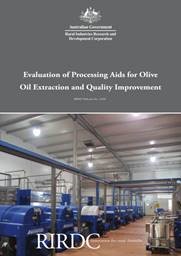
Download report: Evaluation of Processing Aids for Olive Oil Extraction and Quality Improvement | AgriFutures Australia Download Fact Sheet: Evaluation of Processing Aids for Olive Oil Extraction and Quality Improvement fact sheet | AgriFutures Australia Evaluation of Processing Aids for Olive Oil Extraction and Quality Improvement RIRDC Publication 01-091, October 2011 Author(s): Pablo Canamasas, Leandro Ravetti This RIRDC report analyses the impact of the use of traditional and new processing aids on olive oil extraction and oil quality. The information generated by this project aims to provide new tools for improving olive oil processing that can increase both the extraction efficiency and profitability for olive producers in the Australian industry. The report is targeted at the relatively new and actively growing group of olive oil processors in Australia. An understanding of the use of processing aids by oil producers will help them increase their profitability without affecting the quality of their product. Comments: Essential reading for olive oil processors. Profiled in OliveCare® NEWS, April 2019. Reviewer: Pablo Canamasas Review completed – download here |
|
|
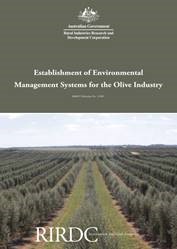
Download report: Establishment of Environmental Management Systems for the Olive Industry | AgriFutures Australia Download factsheet: Establishment of Environmental Management Systems for the Olive Industry fact sheet | AgriFutures Australia Establishment of Environmental Management Systems for the Olive Industry RIRDC Publication 11-089, October 2011 Author(s): N. Quinn This RIRDC report analyses the relationship between the olive industry and the natural system in which it operates. The environmental system described in this report underpins the Australian Olive Association’s environmental charter within its Code of Practice. Comments: Useful reading for all olive producers and for industry representatives. Profiled in OliveCare® NEWS. To Be Advised |
||

Download report: Recycling Solid Waste from the Olive Oil Extraction Process | AgriFutures Australia Recycling Solid Waste from the Olive Oil Extraction Process RIRDC Publication 08-165, October 2008 Author(s): Assoc. N.G. Tan Nair, Julie Markham The report is about developing an environmentally sustainable system to manage solid waste from the 2- and 3-phase olive oil mill extraction processes. The Australian olive industry has been expanding at the rate of about 9% per annum over recent years. This significant increase in fruit production will result in vast quantities of solid and liquid wastes generated to the detriment of the environment. The industry is therefore faced with the challenge to manage these wastes in order to achieve sustainable production under a clean environment. The research was done over three years at three sites in New South Wales using olive husk waste collected from 2005, 2006 and 2007 harvests. The research work reported here is important because it provides the industry with a tool to recycle processed oil mill waste to improve the health of the crop and the status of the soil. Comments: Essential reading for all olive producers. Profiled in OliveCare® NEWS, August 2019. This publication is relevant but needs updating Reviewer: John Barton, Charton&Bang Review completed – download here Review published in OliveCare® News August 2020 Edition |
||
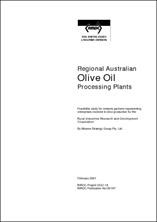
Download report: Regional Australia Olive Oil Processing Plants | AgriFutures Australia Regional Australia Olive Oil Processing Plants RIRDC Publication 00-187, February 2001 Author(s): Meyers Strategy Group Pty. Ltd. This report provides readers with both words and an excel model of the feasibility of processing olives into oil, in Australia. It contains a detailed review of the steps required to establish a group of like minded olive growers, the rationale for the study based on the formation of a new marketing company in Australia to market quality olive oil and associated products in the domestic and export markets. The study was first proposed as a method of establishing how Australia could compete in a rapidly growing olive industry worldwide. The report and financial model draws on actual experience to date as well as date from two major international olive processing companies. Alfa laval and Pieralisi. Comments: This publication is obsolete. |
Olive Oil Storage
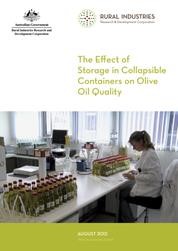
Download report: Effect of Storage Containers on Olive Oil Quality | AgriFutures Australia Effect of Storage Containers on Olive Oil Quality RIRDC Publication 09-160, August 2012 Author(s): Rodney J. Mailer, Kerrie Graham This RIRDC report assesses the impact of storage in a range of flexible storage containers on extra virgin olive oil quality. The research was conducted by the Australian Oils Research Laboratory (AORL). It was supported by RIRDC and the Australian Olive Association. The outcome of this study reinforces that the best storage conditions for olive oil is in opaque, impervious and inert containers, stored at cool temperatures. Stainless steel or glass would appear to be the best options for long term storage. Metallised flexible bags used for short term transport may provide reasonable protection. Storage in clear plastic, particularly in the light and at elevated temperatures, is clearly unacceptable and will result in total loss of extra-virgin olive oil quality within weeks and perhaps days. Re-use of these containers would appear to be highly undesirable and would be expected to cause more rapid degradation. Comments: Essential reading for all olive producers, transporters, warehouse operators, importers and exporters, retailers. Profiled in OliveCare® NEWS, October 2019. This publication is relevant but needs updating. Reviewers: Dr Rod Mailer / Jamie Ayton Review completed Download here |
||
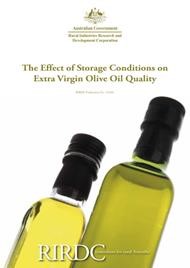
Download report: The Effect of Storage Conditions on Extra Virgin Olive Oil Quality | AgriFutures Australia The Effect of Storage Conditions on Extra Virgin Olive Oil Quality RIRDC Publication 12-024, April 2012 Author(s): Rodney J. Mailer, Kerrie Graham, Jamie Ayton This RIRDC report provides information about the effect of exposure to oxygen, light and storage temperature on the quality of olive oil. Olive oil has been shown to quickly deteriorate when stored under less than ideal conditions. Sometimes growers produce oil with very high quality initially, which quickly deteriorates due to the conditions under which it is stored. The report is targeted at olive oil producers, transporters, warehouse operators, importers and exporters, retailers and consumers. It is important to be aware of the risks of improper storage on olive oil quality whether buying, selling, transporting or storing the product. Comments: Essential reading for all olive producers, transporters, warehouse operators, importers and exporters, retailers. Profiled in OliveCare® NEWS, June 2019. This publication is relevant but needs updating. Reviewers: Dr Rod Mailer / Jamie Ayton Review completed Download here |
|
|

Download report: The Effect of Storage in Collapsible Containers on Olive Oil Quality | AgriFutures Australia The Effect of Storage in Collapsible Containers on Olive Oil Quality RIRDC Publication 12-008, October 2009 Author(s): Rodney J. Mailer, Kerrie Graham, Jamie Ayton This Rural Industries R&D Corporation report is the second part of a study on oil storage. Initial studies at the Australian Oil Research Laboratory (AORL), RIRDC Publication No. 09/160, “Effect of storage containers on olive oil quality”, investigated changes in oil quality when stored in extreme environmental conditions in a range of containers commonly used by growers in the olive oil industry. The oil in some cases deteriorated quickly, reducing oil quality within a short period, sometimes in only a few days. This second study has measured changes in the oil when stored in a temperature controlled environment, away from direct light, reputably the most desirable conditions for storage of olive oil. The chemical parameters which are indicative of oxidation and ageing were monitored and results are reported here. Comments: Essential reading for all olive producers, transporters, warehouse operators, importers and exporters. Profiled in OliveCare® NEWS, June 2019. Publication relevant, may need updating. This publication is relevant but needs updating. Reviewers: Dr Rod Mailer / Jamie Ayton Review completed Download here |
Olive Varieties
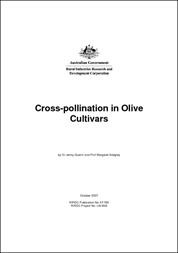
Download report: Cross-pollination in olive cultivars | AgriFutures Australia Cross Pollination in Olive Cultivars RIRDC Publication 07-169, October 2007 Author(s): Jenny Guerin, Margaret Sedgley The aim of this study was to determine the pollen donors for five OLIVE major cultivars, using paternity analysis. Bloom time, pollen vitality, and weather conditions during the flowering period were also recorded. The study was done over two years at two sites and different compatibilities between cultivars were identified. Comments: This publication obsolete needs new project / review of current literature |
||

Download report: National Olive Variety Assessment – Stage 2 | AgriFutures Australia National Olive Variety Assessment – Stage 2 RIRDC Publication 05-155, October 2005 Author(s): Susan Sweeney A major challenge in the establishment of the olive industry has been the selection of varieties best suited to Australian conditions, for optimal yields and quality. There has been limited reliable information and performance data for any olive variety under the wide range of Australian conditions and the industry has relied mainly on Northern hemisphere research and information. Another major issue that has confronted the Australian olive industry is that of ensuring the correct varietal identity of a particular tree, as there is a great deal of confusion in olive variety identification. Performance characteristics of a specific genotype are the basis on which a selection is made for a particular usage or physical situation. Correct identification at the time of tree purchase is therefore critical since mistakes may not become apparent for some years. The National Olive Variety Assessment (NOVA) project was established to help resolve the confusion in olive variety identity and to evaluate the performance, in different climatic regions of Australia, of the majority of known commercial olive varieties. Comments: This publication is of historical value, but needs a major revision / update. |
|
|

Download report: Wild olive selection for quality oil production | AgriFutures Australia Wild olive selection for quality oil production RIRDC Publication 04-101, July 2004 Author(s): Margaret Sedgley While weed olive populations pose an environmental problem, they also offer a unique opportunity to the new fledgling olive industry. The weed populations are so well adapted that they compete successfully with native vegetation. Harnessing this competitive ability will pay dividends in terms of the development of adapted genotypes. This study surveyed wild olive populations across southern Australia and tested for oil yield and quality. Those that were superior to existing cultivars have been propagated and planted under cultivated conditions The resource secures the future of the olive industry in Australia, with the promise of superior adapted cultivars for the future. Comments: This publication is of historical value, but needs a major revision / update. Potential new project on heritage EVOO varieties. |
||
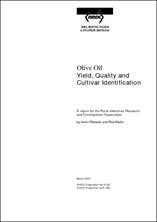
Download report: Olive Oil: Yield, Quality and Cultivar Identification | AgriFutures Australia Olive Oil: Yield, Quality and Cultivar Identification RIRDC Publication 01-023, March 2001 Author(s): Kevin Robards and Rod Mailer Olives were introduced to the Colony of New South Wales on 28th December 1800 by George Suttor, a London market gardener. Production never progressed beyond the cottage industry phase. Demand for olive products has increased dramatically in recent times due to higher incomes and interest in a healthy lifestyle. However, the demand is currently met by imports. Siting of the Wagga Wagga Agricultural Institute (WWAI) and Charles Sturt University (CSU) with an Olive Grove on CSU land was an integral feature of this project. Both agencies have been actively involved with the olive industry in the provision of technical advice to growers and use of the Olive Grove as a training facility. For example, during 1996 a workshop was organised under the auspices of the Australian Olive Association (AOA) at CSU. The workshop included sessions on horticulture, sensory evaluation and production of olives and olive oil. The lack of appreciation of oil quality and flavour was identified as a key issue confronting the Australian olive industry. Comments: This publication is now out of date. Relevant in the historic context of the industry 20 years ago. |
||

Download report: Wild olive selection for quality oil production | AgriFutures Australia Wild olive selection for quality oil production RIRDC Publication 00-116, August 2000 Author(s): UA-41A The olive (Olea europaea L.) is a small evergreen tree adapted to a Mediterranean climate. It yields two products, table olives and olive oil, both of which are important commodities on world markets. One of Australia’s first industries following European settlement was table olive and olive oil production, and many introductions of olive varieties were made from overseas. Despite this, the Australian olive industry went into decline and almost all olive products consumed are now imported. Olives are ideally suited to the southern Australian environment, as demonstrated by its status as an invasive weed, by natural seed propagation from the original introductions. The olive competes so well with native vegetation in disturbed sites, that eradication programs are underway throughout southern Australia in an attempt to preserve bushland areas. It is essential that superior wild material is identified and propagated before it is destroyed, as it represents the progeny of an uncontrolled outcrossing ‘experiment’. Based on this wild material, which is clearly well-adapted to Australia, there is the potential to increase Australian olive oil production, and so to replace imports of olive products currently valued at $100 million. More importantly, the industry intends to develop an export market in olive products, and this is increasingly likely following crop failures overseas. Improved planting material is needed for the industry renaissance. Comments: This publication is of historical value, Olives SA interested in maintaining this collection. Potential new project on heritage EVOO varieties. |

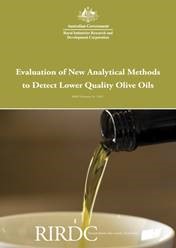 Download report:
Download report: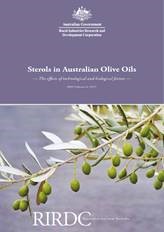 Download report:
Download report: Download report:
Download report: